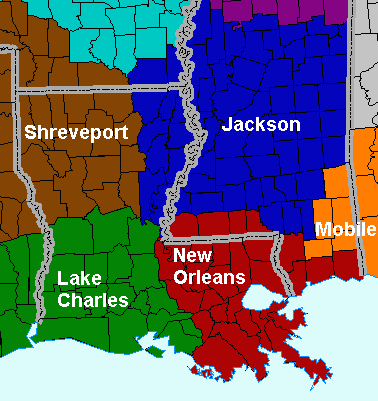National Weather Service Has Issued Severe Weather Awareness Week Tips For Louisianans
NOAA Press Release For New York -
Louisiana
| NWR & Wireless Emergency Alerts | Tornado and Severe Weather Safety Rules |
Louisiana
Severe Weather Awareness Week
March 6 - 10, 2017
Severe Weather Awareness Week Information
Tornadoes, damaging thunderstorm winds, large hail, and flash floods can occur at any time of the year. However, late winter and spring usually bring the greatest chance of these severe weather events happening in Louisiana.
The week of March 6, 2017, has been designated as Severe Weather Awareness Week in Louisiana. The goal of the awareness week is to call attention to the threats posed by these weather hazards and to review severe weather safety rules in an attempt to reduce the loss of life and injury. Post-storm interviews with survivors of severe weather events prove that preventative security measures greatly enhance the chance of survival.
Now is the time to develop a severe weather safety plan. A successful plan should include:
- Knowledge of terminologies such as watches and warnings
- Knowledge of safety rules to follow when severe weather strikes
- A reliable method of receiving emergency information
- Review and testing of the plan.
Emergency managers, schools, government agencies, private businesses, and local citizens are encouraged to review their severe weather safety plans and conduct drills as appropriate.
Louisiana 2016 Severe Weather Summary
Severe weather in Louisiana during 2016 was highlighted by severe weather activity in the southern portion of the state and a minimum of severe weather across the northern sections. A total of 26 tornadoes were recorded across the state, all occurring in central and south Louisiana. While North Louisiana had extensive heavy rain and flooding in the spring months, there were no tornadoes reported during the normally active spring season, or during the remainder of the year.
The most significant severe weather outbreak in 2016 occurred in south central and southeast sections on February 23 when 12 tornadoes were reported, with 3 of those tornadoes rated as strong, EF2 or EF3 on the Enhanced Fujita Scale. The most significant was a strong tornado, (EF2/3), that produced significant property damage as it tracked 21 miles across Assumption and St James Parishes in southeast Louisiana. Unfortunately, there were 2 fatalities and approximately 75 injuries when the tornado plowed through an RV park in St James Parish. The remainder of the tornadoes reported in the state in 2016 were weak, (EF0 or EF1), producing mainly minor to moderate property damage.
The only other fatalities from severe weather during 2016 were lightning-related. Lightning struck a music festival on the evening of March 18 in Lafourche Parish, resulting in one death and two injuries. Two outdoor construction workers were killed in southeast Louisiana in separate events, April 27 and July 14, respectively. A Pineville man was killed on July 10 when lightning struck while he was holding an umbrella.
So far the early portion of 2017 has been marked by active severe weather in both northwest and southeast Louisiana. Strong tornadoes occurred in far northwest Louisiana on January 23 with additional strong storms occurring several weeks later on February 7th in southeast Louisiana. Both events produced extensive property damage and injuries.
2016 Louisiana Tornado Highlights
- Total Number of Tornadoes: 26
- Number of Strong Tornadoes: 3 - one EF3 and two EF2 on Enhanced Fujita Scale
- Average Annual Tornadoes: 37 - (averaging period 1991-2010)
- Number of Tornado Injuries: 77
- Number of Tornado Deaths: 2
When In Dought Please Remember To Follow These Simple Safety Rules:
NWS Local Forecast Office Areas of Responsibility
 |
During a threat of Severe Weather – carefully monitor the weather and the latest forecast.
If a Watch is issued – stay alerted and be prepared to take action
If a Warning is issued – take action
- Seek shelter in an interior room on the lowest floor of your home or business such as a closet, bathroom, or hallway
- Protect your head from flying debris! If possible, use a helmet, mattress, pillow, or anything that will provide better protection than your hands
- Abandon mobile homes and vehicles for more substantial shelter
- Stay away from windows, and do not waste time trying to open them
- Do not take shelter under a highway or overpass


Comments
Post a Comment